KWin/zh-tw: Difference between revisions
m (Created page with "右擊視窗裝飾(就是標題列)或開啟 系統設定 存取 '''KWin''' 新的更容易的設定。在這你可以啟用特效以...") |
m (Created page with "如果你的 X server 已經支援「混成」,那簡單的開啟「系統設定」,進入<menuchoice>桌面</menuchoice>模組,選擇<menuchoice>桌面效果</menuchoice>...") |
||
| Line 19: | Line 19: | ||
右擊視窗裝飾(就是標題列)或開啟 [[Special:myLanguage/System Settings|系統設定]] 存取 '''KWin''' 新的更容易的設定。在這你可以啟用特效以便更有效的管理你的視窗。比如你能用'''視窗輪轉(Present Windows)'''作為"視窗切換"的特效。不同於顯示圖示或是小的程式預覽縮圖,他安排整理執行中的視窗在同一個網格內,然後你能快速的選擇你要的那個視窗。只要使用 <keycap>Alt-Tab</keycap>快捷鍵組合,保持ALT按鍵一直按住。現在你能用 <keycap>Alt</keycap>按鍵遍歷選擇視窗或用滑鼠; 啟動相應的視窗。快速的擊打 <keycap>Alt-Tab</keycap>按鍵會顯示佇列中下一個視窗,就如以前一樣。 | 右擊視窗裝飾(就是標題列)或開啟 [[Special:myLanguage/System Settings|系統設定]] 存取 '''KWin''' 新的更容易的設定。在這你可以啟用特效以便更有效的管理你的視窗。比如你能用'''視窗輪轉(Present Windows)'''作為"視窗切換"的特效。不同於顯示圖示或是小的程式預覽縮圖,他安排整理執行中的視窗在同一個網格內,然後你能快速的選擇你要的那個視窗。只要使用 <keycap>Alt-Tab</keycap>快捷鍵組合,保持ALT按鍵一直按住。現在你能用 <keycap>Alt</keycap>按鍵遍歷選擇視窗或用滑鼠; 啟動相應的視窗。快速的擊打 <keycap>Alt-Tab</keycap>按鍵會顯示佇列中下一個視窗,就如以前一樣。 | ||
如果你的 X server 已經支援「混成」,那簡單的開啟「系統設定」,進入<menuchoice>桌面</menuchoice>模組,選擇<menuchoice>桌面效果</menuchoice>,然後勾選「啟用桌面效果」來切換。更多高階的混成設定(比如''VSync 操作'',''直接渲染'',''混成型式'')可透過<menuchoice>高階</menuchoice>分頁操作。自訂KWin特效的行為可開啟<menuchoice>全部效果</menuchoice>標籤,選擇你想要用的外掛程式。請注意只有一部份外掛程式能在 ''XRender'' 型式混成下工作。要獲得完全的體驗,你需要使用 OpenGL 型式。 | |||
Employing motion physics, '''KWin''' provides your windows with a more natural feel. New desktop effects like the '''Cube''' desktop switcher and '''Magic Lamp''' minimize animation have been added. Improvements in the existing effects make window management smoother than ever. KWin has seen many performance improvements to enable these effects even on low-end hardware. Elaborate checks have been build in to ensure users with low-end hardware are not presented with an unusable setup. KWin detects the capabilities of the hardware and if needed gracefully scales its effects down. You can take control and disable these checks or change settings like the global animation speed to fine-tune your experience. When your computer is under heavy load, '''KWin''' will automatically disable the compositing temporarily to keep things running smoothly. It will notify you if it does so, and you can re-enable compositing by pressing <keycap>Shift+Alt+F12</keycap>. Finally, support for multiple screen handling has been improved in '''KWin''' using the new '''Kephal''' library. You can move maximized windows between '''Xinerama''' screens and the addition of external screens is handled correctly. | Employing motion physics, '''KWin''' provides your windows with a more natural feel. New desktop effects like the '''Cube''' desktop switcher and '''Magic Lamp''' minimize animation have been added. Improvements in the existing effects make window management smoother than ever. KWin has seen many performance improvements to enable these effects even on low-end hardware. Elaborate checks have been build in to ensure users with low-end hardware are not presented with an unusable setup. KWin detects the capabilities of the hardware and if needed gracefully scales its effects down. You can take control and disable these checks or change settings like the global animation speed to fine-tune your experience. When your computer is under heavy load, '''KWin''' will automatically disable the compositing temporarily to keep things running smoothly. It will notify you if it does so, and you can re-enable compositing by pressing <keycap>Shift+Alt+F12</keycap>. Finally, support for multiple screen handling has been improved in '''KWin''' using the new '''Kephal''' library. You can move maximized windows between '''Xinerama''' screens and the addition of external screens is handled correctly. | ||
Revision as of 13:31, 31 October 2010
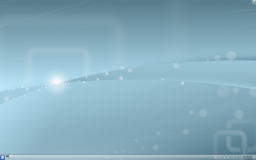 |
The reliable and flexible window manager for KDE Plasma Desktops, now with effects! |
特性預覽
- 穩定和可靠
- 混合的 3D 效果
- 容易設定
- 改進的效率
KWin (發音"kwin")是 KDE Plasma 桌面 的視窗管理員。他讓你完全操控你的視窗,確保他們不是在妨礙工作而是在說明你完成任務。他繪製視窗裝飾,每個視窗頂部的欄,帶有(可定製的)按鈕比如關閉,最大化和最小化。他同樣處理視窗移動和互相切換。
KWin 支援混成特性(compositing), 意味著能夠使用 3D 效果來處理你的視窗。這使得視窗管理更平滑,更容易,更有效和更自然。它的硬體要求非常的適當,幾乎每個相當於2002年之後的現代系統都支援它。與某些硬體還存在一些問題,要了解更多資訊,請點擊techbase
實用功能
右擊視窗裝飾(就是標題列)或開啟 系統設定 存取 KWin 新的更容易的設定。在這你可以啟用特效以便更有效的管理你的視窗。比如你能用視窗輪轉(Present Windows)作為"視窗切換"的特效。不同於顯示圖示或是小的程式預覽縮圖,他安排整理執行中的視窗在同一個網格內,然後你能快速的選擇你要的那個視窗。只要使用 Alt-Tab快捷鍵組合,保持ALT按鍵一直按住。現在你能用 Alt按鍵遍歷選擇視窗或用滑鼠; 啟動相應的視窗。快速的擊打 Alt-Tab按鍵會顯示佇列中下一個視窗,就如以前一樣。
如果你的 X server 已經支援「混成」,那簡單的開啟「系統設定」,進入模組,選擇,然後勾選「啟用桌面效果」來切換。更多高階的混成設定(比如VSync 操作,直接渲染,混成型式)可透過分頁操作。自訂KWin特效的行為可開啟標籤,選擇你想要用的外掛程式。請注意只有一部份外掛程式能在 XRender 型式混成下工作。要獲得完全的體驗,你需要使用 OpenGL 型式。
Employing motion physics, KWin provides your windows with a more natural feel. New desktop effects like the Cube desktop switcher and Magic Lamp minimize animation have been added. Improvements in the existing effects make window management smoother than ever. KWin has seen many performance improvements to enable these effects even on low-end hardware. Elaborate checks have been build in to ensure users with low-end hardware are not presented with an unusable setup. KWin detects the capabilities of the hardware and if needed gracefully scales its effects down. You can take control and disable these checks or change settings like the global animation speed to fine-tune your experience. When your computer is under heavy load, KWin will automatically disable the compositing temporarily to keep things running smoothly. It will notify you if it does so, and you can re-enable compositing by pressing Shift+Alt+F12. Finally, support for multiple screen handling has been improved in KWin using the new Kephal library. You can move maximized windows between Xinerama screens and the addition of external screens is handled correctly.
More information about what was introduced in KDE SC 4.2 can be found at the following link:
Tutorials
You want an application to launch in a specific size and position every time
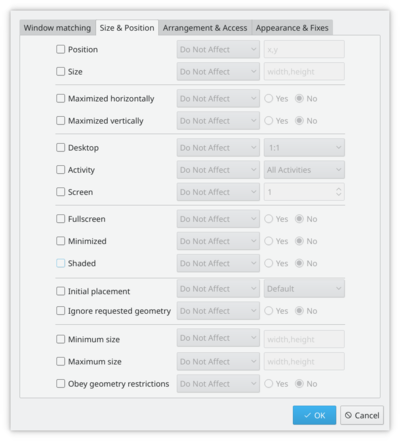
Sometimes the screen position of an application is vital to your comfort, so use the flexibility of KWin to make sure it's always where you want it.
Position the window where you want it to open, then right-click on the title-bar, choosing . This will open a settings window, with appropriate entries already made. All you need to do now is select the tab and check and . OK - you're finished!
Script the window manager from the command line
Use the WMIface utility.
Customise the position of titlebar buttons
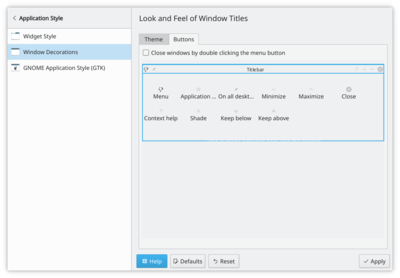
Take a look at tab - and enable . The options open to you may depend on your distribution or theme, and it's clear that there is more to come.
Perhaps you would like more space between the button and the pair? So you will want to add a - two if you wish.
To simply move things around you work with the speciman titlebar - that is the dark blue bar with a large KDE on it. Drag icons there and you will see them move in the preview window at the bottom of the screen.
You may find that you have other icons available to you. A circle indicates that the button will set that window on all desktops. Another icon that you may find useful is Shade - a toggle between rolled up (titlebar only visible) and normal view. These icons are added by dragging from the text description window onto the speciman title bar - just position them as you want to use them.
If you prefer a Classic, KDE3-style Desktop

|
| Change to traditional desktop |
Right-click on your desktop - select (or , in some distros). Change the from to . The whole desktop is now a folderview, and another right-click on the desktop will allow you to select . Set the folderview to the directory you want to use as your desktop.
A video of KWin features
A demonstration of features is here
Open applications directly into a different desktop
Use commands like
kstart --desktop 4 kate
Using with small screens (eg Netbooks)
Make the window decorations smaller
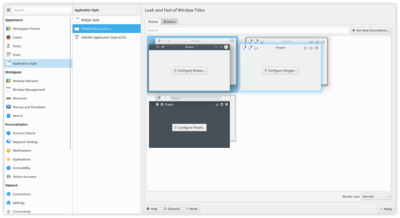
tab. Two good options there:
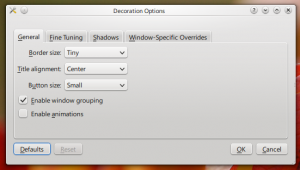
- Using the default style (Oxygen), select and set to and to
- Select the
Both routes will give you slim and functional window titles and borders.
Change the base fonts
On many netbooks the screen is very clear, so that reading fonts much smaller than you expect is feasible. On my Acer Aspire One I find that 8 point is a good base settings.
Make Firefox use smaller fonts
Experimentation with did not bring satisfactory results. Do this instead. Download and install gtk-chtheme from this website. Using that tool you can either set a specific font size, or better still, tell it to use your KDE desktop settings. This will work with Firefox as well as any gtk applications that you use.
KMail's Aggregation options take up too much space
See this FAQ to change it.
KMail's Folder-List Tooltips hide too many folder names
See this FAQ to change their behaviour
Gallery
The Gallery holds many screenshots of past and present desktops and effects.
